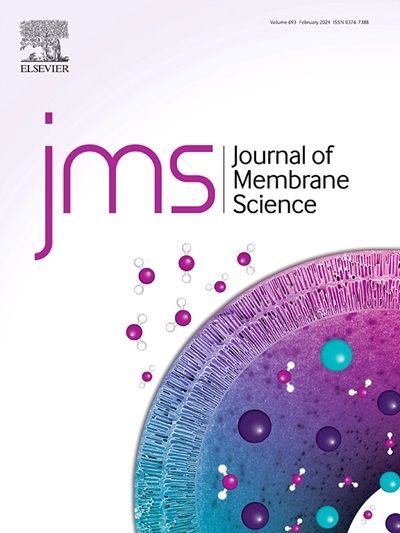Evaluation of the adsorptive behaviour of kraft black liquor on nanofiltration model membrane surfaces via quartz crystal microbalance with dissipation monitoring (QCM-D)
IF 8.4
1区 工程技术
Q1 ENGINEERING, CHEMICAL
引用次数: 0
Abstract
Membrane filtration of kraft black liquor (KBL), a side-stream of the pulp and paper industry, is challenged by membrane fouling caused by its multicomponent complexity. The specific contributions of the components found in KBL to the fouling and the characteristics of the fouling layer that they create has not been investigated. Herein, the adsorptive and desorptive behaviours of KBL ultrafiltration (UF) permeate, along solutions of lignin and of hemicelluloses, were studied in real time using quartz crystal microbalance with dissipation monitoring (QCM-D) at 30 °C and 50 °C. Quartz sensors were coated with a polymer to model a nanofiltration (NF) membrane surface. The results revealed that hemicelluloses adsorbed rapidly, forming a relatively soft layer on the model membrane surface, while lignin adsorbed slowly and formed the most stable fouling layer of the three solutions at 30 °C. The KBL UF permeate layers had softest structure with most of the foulants being rinsed away at 30 °C. At 50 °C, the KBL UF permeate layer before sodium hydroxide (NaOH) rinsing was driven by multicomponent assembly—unlike single-component systems, the adsorbed mass exceeded the sum of individual hemicelluloses and lignin contributions, underscoring temperature-enhanced diffusion and co-deposition. After NaOH rinsing at 50 °C, all the fouling layers were softer, rougher, and more hydrophilic compared to those at 30 °C. Especially, a hybrid fouling layer with the highest surface roughness and the strongest hydrophilicity was created by KBL UF permeate, incorporating scaling-resistant deposits formed by residual sodium salts and crosslinked organics. These findings may provide essential knowledge for improving membrane cleaning efficiency of irreversible fouling caused by KBL UF permeate.

求助全文
约1分钟内获得全文
求助全文
来源期刊

Journal of Membrane Science
工程技术-高分子科学
CiteScore
17.10
自引率
17.90%
发文量
1031
审稿时长
2.5 months
期刊介绍:
The Journal of Membrane Science is a publication that focuses on membrane systems and is aimed at academic and industrial chemists, chemical engineers, materials scientists, and membranologists. It publishes original research and reviews on various aspects of membrane transport, membrane formation/structure, fouling, module/process design, and processes/applications. The journal primarily focuses on the structure, function, and performance of non-biological membranes but also includes papers that relate to biological membranes. The Journal of Membrane Science publishes Full Text Papers, State-of-the-Art Reviews, Letters to the Editor, and Perspectives.
 求助内容:
求助内容: 应助结果提醒方式:
应助结果提醒方式:


